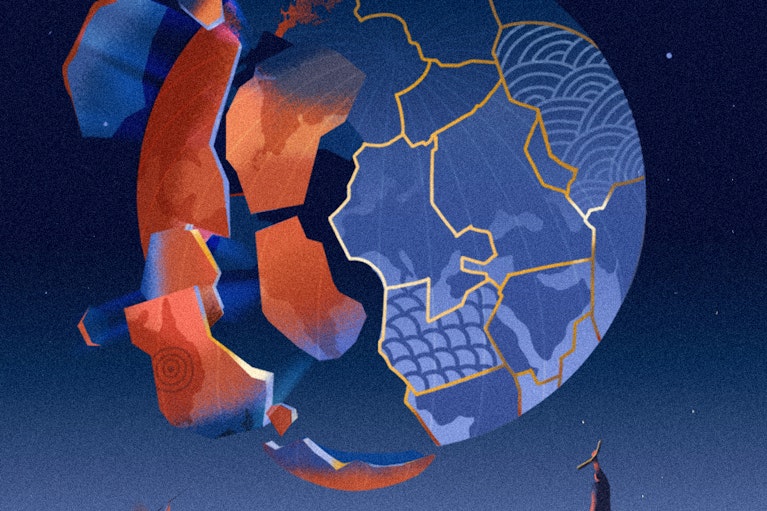Nathan Gardels is the editor-in-chief of Noema Magazine. He is also the co-founder of and a senior adviser to the Berggruen Institute.
In the middle of the 20th century, the American Dream of opportunity and social mobility was the envy of nations around the world, which the rising rest sought to mimic.
In 1956, Indonesian President Sukarno received an audience of Hollywood executives. He told them, “I regard you as political radicals and revolutionaries who have greatly hastened political change in the East. What the Orient sees in a Hollywood movie [portraying American life] is a world in which ordinary people have cars, electric stoves and refrigerators. So the Oriental regards himself as an ordinary person who has been deprived of the ordinary man’s birthright.”
When the Cold War thawed and unlocked the flow of trade and investment, American-led “Globalization 1.0” sought to exploit this world market of aspirations, spreading the wealth that enriched local elites and bolstered the birth of a global middle class — while the majority in the Global South remained poor. The migration of capital from advanced nations also took the manufacturing jobs and opportunities of the working class at home with it, diminishing for them the dream others so admired.
Even though the north star has dimmed and populist hostility has grown in Europe as well as America, migrants from the left behind of the Global South still cross perilous seas, navigate tangled jungles and trek through inhospitable deserts to the borders of hope because they lack any chances at all in those forlorn places where fate had cast their destiny. Desperation as much as aspiration drives them northward despite daunting odds.
Migration Of Capital Vs. People
Absent an approach that harnesses migrating capital to poverty alleviation, the migration of people in the other direction across the planet will explode further. In this respect, China has demonstrated in practice a developmental model worthy of adapting that lifted 800 million people out of impoverishment.
As Jacob Dreyer writes in Noema, the Chinese approach offers a more realistic and attainable path out of poverty for the masses of the Global South than the Western way.
Under the fledgling regime we might call Globalization 2.0, China is deploying its decades of accumulated capital from integrating with the West to compensate for the decoupling of that relationship by exporting its developmental approach focused on trade, infrastructure investment and technology transfer to the Global South. It does so both through entrepreneurial as well as state-backed endeavors such as the Asian Infrastructure Investment Bank and the Belt and Road Initiative.
While the China of Maoist times sought to find ideological allies in what used to be called the “third world,” today it is looking for markets with the huge growth potential that comes from lifting the majority out of poverty and bringing them into the marketplace as consumers. Party theorist Zheng Bijian has put it this way: “The new phase of globalization will be a reverse from the past in which the developed world was the growth engine.”
As Dreyer writes from Shanghai:
China is selling the developmental model that raised its people out of obscurity and poverty to developed global superpower status in a few short decades to countries with people who have decided that they want that too.
The world China is reorienting itself to is a world that, in many respects, looks like China did a generation ago. On offer are the basics of development — education, health care, clean drinking water, housing. But also more than that — technology, communication and transportation. …
Across the vastness of a world that most first-worlders would not wish to visit, Chinese entrepreneurs are setting up electric vehicle and battery companies, installing broadband and building trains. … [F]ast-growing countries from Bangladesh to Brazil can send raw materials to China and get technological devices in exchange. The idea is that what China is today, they could be tomorrow.
Dreyer notes that when Brazilian President Luiz Inacio Lula da Silva met Chinese President Xi Jinping in April he was seeking to branch out from exporting soy and iron ore to China to attracting direct investment for the reindustrialization of his nation. Three months after that meeting, the Chinese battery and electric vehicle giant BYD announced a $624 million investment to build a car manufacturing factory in Latin America’s largest country.
There are valid worries that this exchange of raw materials for high-value goods, especially when purchased through debt dependence, is nothing more than a new twist on imperialism. One case in point is Sri Lanka, where a major port China financed was repossessed because the debt service could not be paid. To the extent, however, that the assumed debt is sustainable and the benefits flow not only to what Marxists call the “comprador class,” but to raising the living standards of the whole society, it has to be considered a net plus.
Raghuram Rajan, a former head of India’s central bank, warily assessed it this way in one conversation: “If the Belt and Road is part of a larger attempt to build out infrastructure, it is good. Obviously, there is a certain degree of China centrism in this. But if the capabilities being built allow for a further set of ties for development — logistical networks and citizen networks connecting different places — it can only help boost economic activity.”
The Bottom Line
Dreyer sums up the appeal of China’s developmental approach: “The majority of human beings alive today live in a world of not enough: not enough food; not enough security; not enough housing, education, health care; not enough rights for women; not enough potable water. They are desperate to get out of there, as China has. They might or might not like Chinese government policies or the transactional attitudes of Chinese entrepreneurs, but such concerns are usually of little importance to countries struggling to bootstrap their way out of poverty.”
In closing, Dreyer situates China’s role in 2023 by contrasting it to 1955 when the post-colonial nations met at Sukarno’s behest in Bandung, Indonesia to consider their common challenges. Then, “the non-aligned world was almost entirely poor, cut off from the means of production in a world where nearly 50% of GDP globally was in the U.S. Today, the logic of that landmark conference is alive in Chinese informal networks across the Global South, with the key difference that China can now offer these countries the possibility of building their own future without talking to anyone from the Global North.”
The American-led West should understand that its preoccupation with China’s challenge to its dominance does not stop the rest of the world from spinning. If China offers a better alternative to those who are determined to rise, they will take it.






